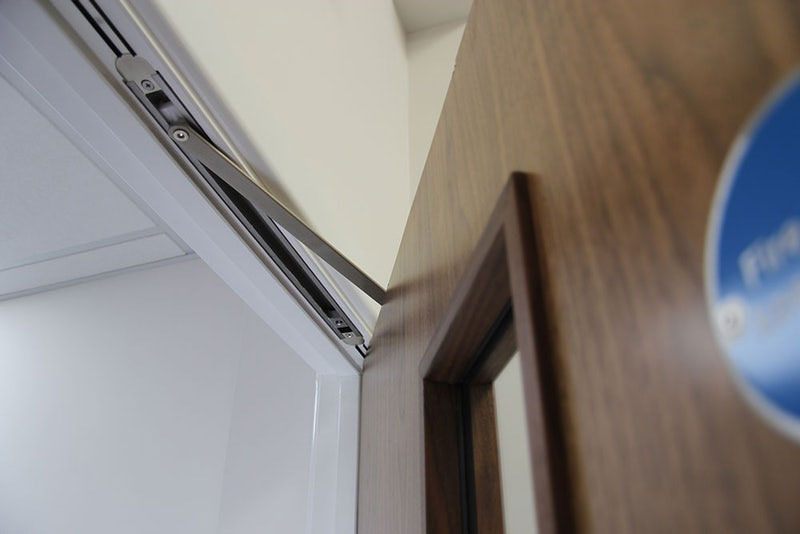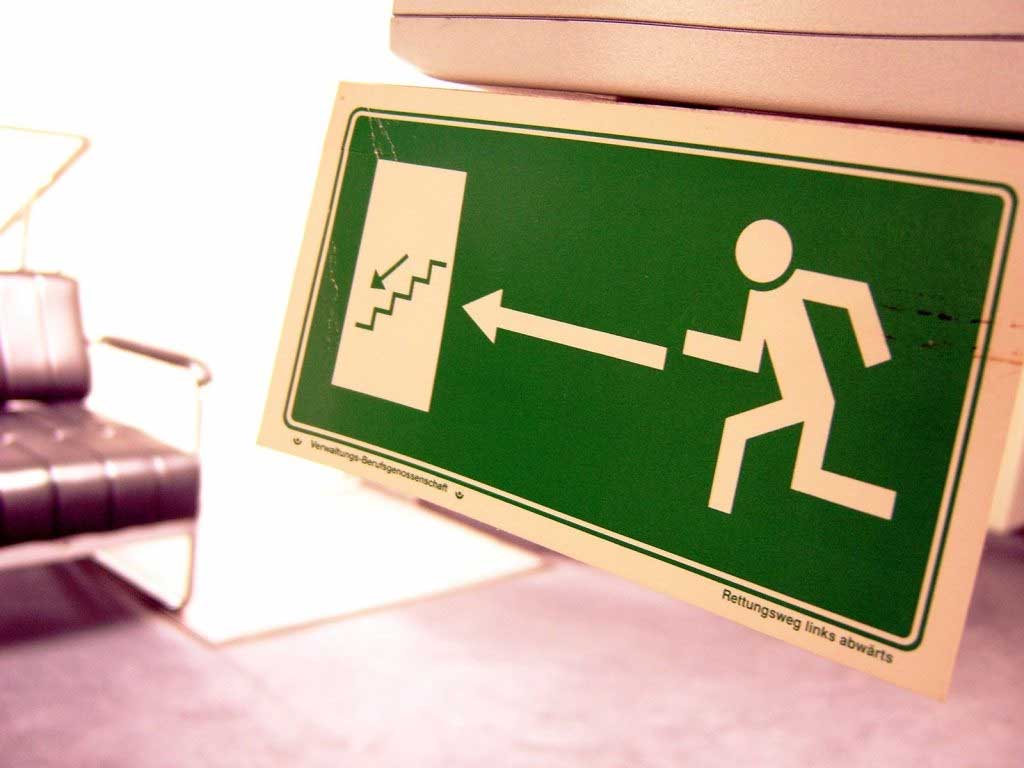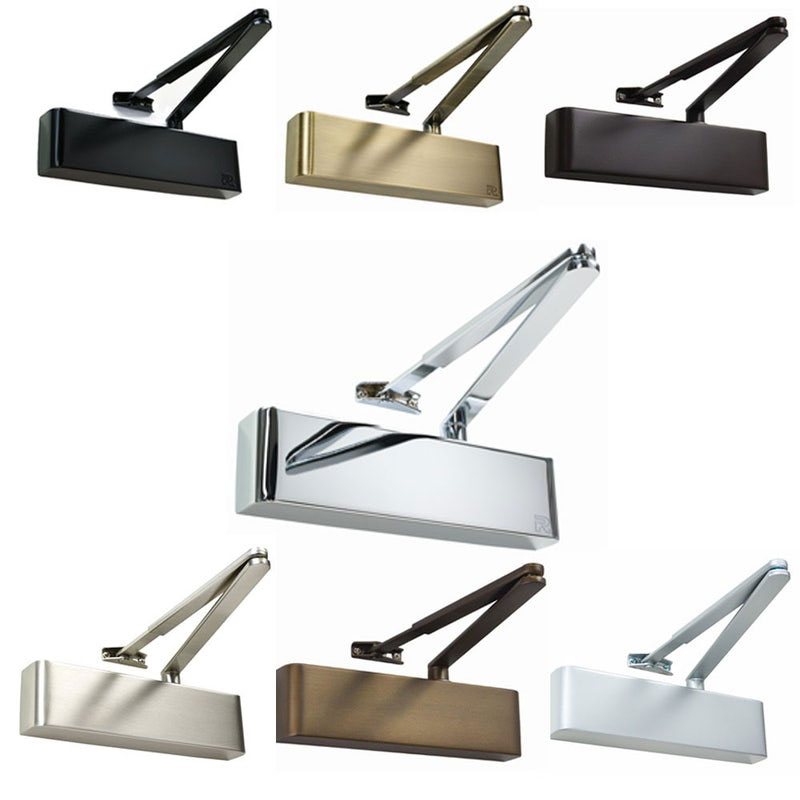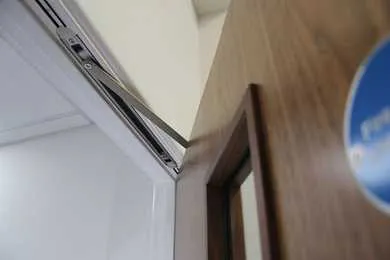There are many things to consider in terms of fire protection. So when considering hardware to improve fire safety in your building, fire door closers could be essential to the safety of those within the property. Especially if you are responsible for the lives of others.
If fire door safety is a priority for you, a fire door closer is another piece of hardware that you will need to install to ensure you follow personal and legal requirements. Find out more about fire door closers below, as well as the regulations surrounding them.
Table of contents
- What are fire door closers?
- Fire door closer regulations
- Door closers on fire doors
- Fire door closers – how to fit!
What are fire door closers?
A fire door closer, also known in some cases as a self-closing device, is typically installed at the top of a door to ensure the door shuts automatically to maintain fire safety. They can be used for residential or commercial settings and come in a wide variety of designs to suit individual requirements. Moreover, not only can fire door closers be used for protection in the event of a fire, but also reduce heat loss during colder temperatures.
Fire door closers also come with fire door ratings. These ratings are vital in highlighting how long a fire door closer can support the protection of the property should a fire be caused. Current fire door ratings are as follows:
- FD30 – 30 minutes (1/2 hr)
- FD60 – 60 minutes (1hr)
- FD90 – 90 minutes (1 1/2 hrs)
- FD120 – 120 minutes (2hrs)

Fire door closer regulations
A fire door closer can also be referred to as a self-closing device, as stated in Approved Document B. A self-closing device is stated as ‘a device that closes a door, when open at any angle, against a door frame.’ Leading with this, Approved Document B also states the following:
“All fire doorsets, including to flat entrances and between a dwellinghouse and an integral garage, should be fitted with a self-closing device…”
This does not include fire doorsets that lead to cupboards or service ducts normally locked shuts, as well as fire doorsets within flats and dwellinghouses (e.g. common internal doors).
So if you’re wondering whether all your doors will need a self-closing device – no. Not all doors need a fire door closer. Having said this, you can determine whether your door needs a fire door closer with the following:
- If the fire doorset leads to a common escape route (e.g. external escape stair)
- If the fire doorset sits between the garage and the dwellinghouse
- If two fire doorsets are fitted in the same opening with the opening provided as a means of escape
- If a fire doorset separates the dead-end portion of a common corridor from the rest of the corridor
If you are responsible for the lives of others in a residential or even non-residential space then you will need to make sure that you are providing legally adequate safety measures.
It’s also worth noting that should a home have a floor more than 4.5m above ground level, such as a property with two storeys and a loft conversion or three storeys and beyond must have door closers installed on all doors above the second floor of a building where applicable. In this case, you will also need to install door closers to any door between the property and the garage as mentioned in the listing above.
Residential spaces can include, but are not limited to:
- Dwellings (flats etc)
- Institutional (hospitals, homes, schools etc)
- Other (hotels, boarding houses, residential colleges, hall of resistance, hostels etc)
Non-residential spaces that still may require fire prevention include the following, but again are not limited to:
- Offices (used for administration, communications, handling money, radio etc)
- Shops and commercial (retail trade or business, premises to which the public is invited etc)
- Assembly and recreation (bingo halls, broadcasting, casinos, entertainment, conference, museums etc)
- Industrial (factories etc)
- Storage and other non-residential (place for storage or deposit of goods or materials etc)
As always, please refer to the latest Approved Document B for up-to-date fire safety guidance. See ‘Table 01 Classification’ of purpose groups in the said document if you would like further information regarding the different types of properties stated above.
Moreover, if you are a private homeowner, it is recommended you install fire door closers where needed but is ultimately at the homeowner’s discretion. Review the legal requirements above and via Approved Document B to ultimately confirm whether a door closer is needed.
Is it okay to wedge open a fire door?
As a general rule, you should not wedge or prop open a fire door as their job is to protect against fire flames and smoke for a specified amount of time when closed. In fact, propping open a fire door can risk legal action as you are putting lives in danger. So while not illegal on its own, the consequences and risks of doing so are still reasons to ensure your door is closed and can close automatically when not in use.
For example, should a fire break out and the fire door be wedged open at that time, legal action in the form of an extensive fine or in some cases imprisonment can occur. So investing in a door closer to ensure your door stays closed can help you stay in line with legal requirements.
You could also be putting your insurance at risk as insurers are more likely to be unwilling to pay for damages when fire doors have been wedged open.
Having said all this, paragraph C6 within Approved Document B states if the self-closing device is considered an interference with the normal approved use of the building, the door may be held open via one of the following solutions:
- Fusible link – only if the doorset is not in an opening provided as a means of escape unless it complies with paragraph C7 in Approved Document B.
- Automatic release mechanism – activated by automatic fire detection and alarm system
- Door closer delay device
So regardless of how common wedging a fire door open might be, it’s better to be safe than sorry and invest in a suitable fire door closer. You can view our range of fire door closers and other fire door hardware at Door Superstore to make sure your building is fire safe.

Door closers on fire doors
Although you will need to consider the weight and size of the door when choosing a closer, fire door closers aren’t limited in design. Alongside the finishing difference, they can also be purchased with different mechanisms. One set of door closers includes controlled door closing devices which are as follows:
- Cam action door closers: These are favoured for their concealed sidearm, cam and roller mechanism. Thanks to this, the mechanism has less friction which makes the door easier to open. As a result, it’s great for assisting Approved Document M contracts and meeting BS8300 recommendations. They are also typically tested to meet BS EN1154 standards, meaning they have completed health, safety and environmental regulations.
- Rack and pinion door closers: This type of door closer can be fitted on most common fire doors or even standard door types and is ideal for mid-range contracts. It is commonly used but lacks the efficiency a cam action door closer might provide. Having said this, these types of door closers are also typically tested to BS EN1154 standards.
In another case, we have automatic fire door closers. These are usually electrically powered hold-open devices that meet BS EN 1155 standards. Automatic door closers can be triggered by several different actions, including but not limited to:
- Alarm activation (by automatic fire detection or manual calling point)
- Acoustic signal (from any system activation) or wireless signal (from a specific system activation)
- Fire warning system failure
- Manual release from someone present in the building
- Failure of power supply
We also know door closers aren’t exactly the prettiest of hardware. That is why the option of concealed door closers exists as well. So if you do want something hidden and at reduced risk of vandalism, then a concealed door closer can be beneficial.
Note: The power size of the door closer will depend on the weight of the door. Here is a brief overview of door closer power sizes:
| EN1154 power size | Door width (max) | Door weight (max) |
| 1 | 750mm | 20kg |
| 2 | 850mm | 40kg |
| 3 (minimum requirement for fire doors) | 950mm | 60kg |
| 4 | 1100mm | 80kg |
| 5 | 1250mm | 100kg |
| 6 | 1400mm | 120kg |

Fire door closers – how to fit
To fit a fire door closer, you will need the following:
- Fire door closer (with fittings)
- Fire door closer installation template (typically provided with the product; if not, speak to the manufacturer)
- Tape measure
- Tape
- Screwdriver
- Spirit level
- Spanner
- Metal screws (confirm size if not provided as part of fittings)
- Drill
Now onto the fitting process for a door closer! For this example, we will be using an overhead door closer. You will also need to make sure that the fire door and frame are in good condition before you start and that the door freely closes in place.
Step one: Using your tape measure, measure the width of the face of your door to confirm your fire door closer can be used for the size door you’re fitting the closer to.
Step two: Find the right fire door closer installation template for your door and set this template where the closer will be mounted and handled (typically on the top corner near the door and door frame). You can use tape to hold it in place temporarily. Make sure that the template layout is correct. If unsure, confirm with the manufacturer.
Step three: Using the template that is sitting on your door, take your screwdriver and mark where you will need to make pilot holes by putting a slight dent through each marked screw spot on the paper.
Step four: Using a spirit level to make sure the drilling is straight, drill pilot holes where you have marked – this helps to prevent wooden doors especially from splitting – then take the main body of the system and place it against the door to screw the system in place with the screws provided.
Step five: Carefully separate the two arm parts (this will be your arm shoe and link arm). Securely fix the adjuster arm shoe to the door frame, making sure it sits in the correct position (some templates can help confirm this position), and the link arm to the main body of the system that has already been attached to the door.
Step six: Fit the spindle cap using a wrench to adjust the position as necessary and test the system by opening and closing the door. Adjust this as needed to ensure suitable closing and latching speed is met for the door.
There you have it! A newly fitted door closer.
Note: If you would like to fit the door closer onto the side of the door which will be pushed instead of pulled, follow the instructions as set but fit the body of the closer on the door frame and the arm on the door.
If you need further advice regarding fire doors and hardware, look to our range of fire door guides via our Help and Advice section. You can also contact our friendly customer service team for support with your enquiries via the helpline or live chat.




